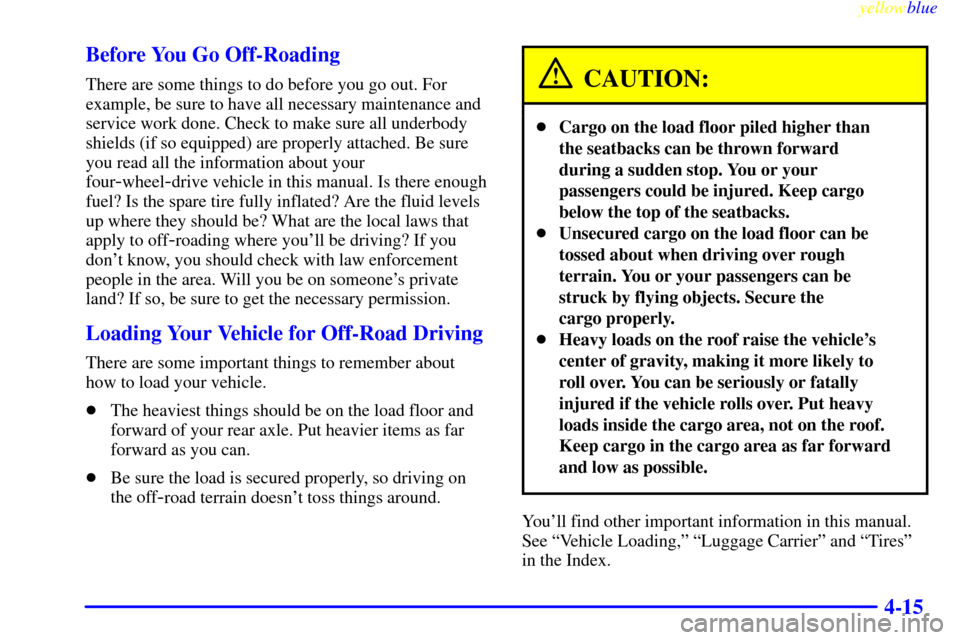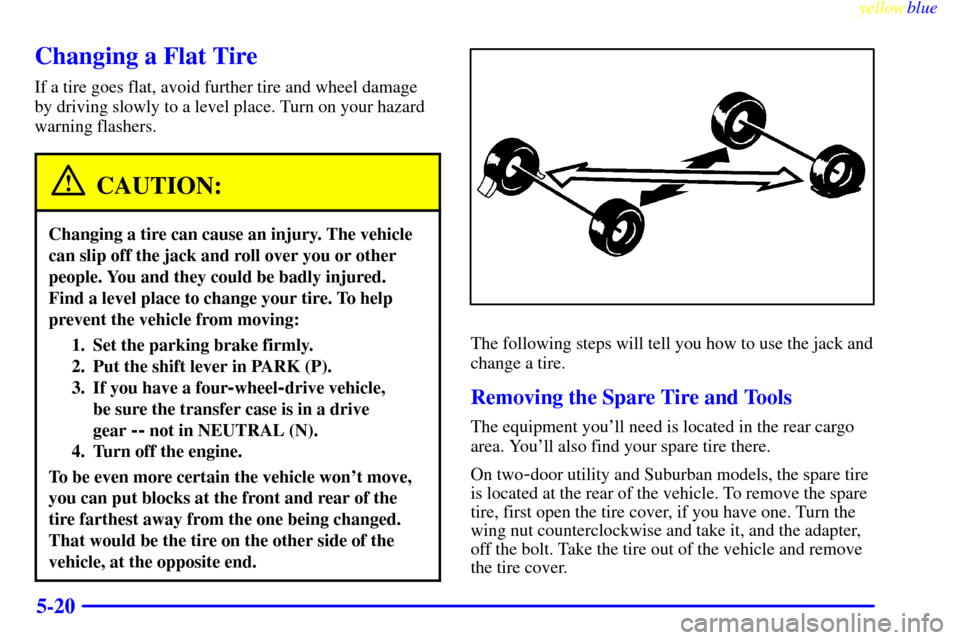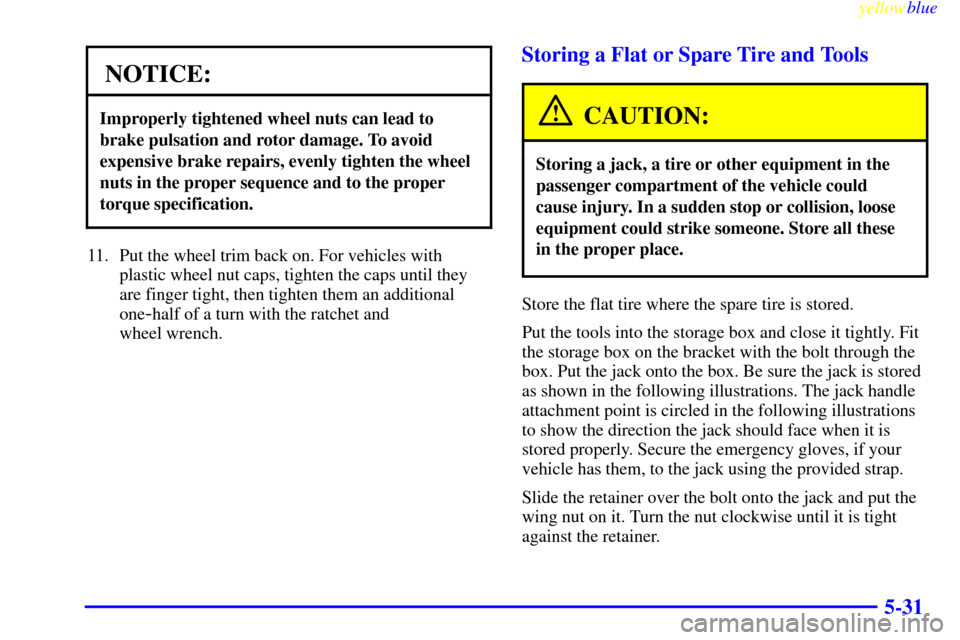Page 197 of 424

yellowblue
4-15 Before You Go Off-Roading
There are some things to do before you go out. For
example, be sure to have all necessary maintenance and
service work done. Check to make sure all underbody
shields (if so equipped) are properly attached. Be sure
you read all the information about your
four
-wheel-drive vehicle in this manual. Is there enough
fuel? Is the spare tire fully inflated? Are the fluid levels
up where they should be? What are the local laws that
apply to off
-roading where you'll be driving? If you
don't know, you should check with law enforcement
people in the area. Will you be on someone's private
land? If so, be sure to get the necessary permission.
Loading Your Vehicle for Off-Road Driving
There are some important things to remember about
how to load your vehicle.
�The heaviest things should be on the load floor and
forward of your rear axle. Put heavier items as far
forward as you can.
�Be sure the load is secured properly, so driving on
the off
-road terrain doesn't toss things around.
CAUTION:
�Cargo on the load floor piled higher than
the seatbacks can be thrown forward
during a sudden stop. You or your
passengers could be injured. Keep cargo
below the top of the seatbacks.
�Unsecured cargo on the load floor can be
tossed about when driving over rough
terrain. You or your passengers can be
struck by flying objects. Secure the
cargo properly.
�Heavy loads on the roof raise the vehicle's
center of gravity, making it more likely to
roll over. You can be seriously or fatally
injured if the vehicle rolls over. Put heavy
loads inside the cargo area, not on the roof.
Keep cargo in the cargo area as far forward
and low as possible.
You'll find other important information in this manual.
See ªVehicle Loading,º ªLuggage Carrierº and ªTiresº
in the Index.
Page 262 of 424

yellowblue
5-20
Changing a Flat Tire
If a tire goes flat, avoid further tire and wheel damage
by driving slowly to a level place. Turn on your hazard
warning flashers.
CAUTION:
Changing a tire can cause an injury. The vehicle
can slip off the jack and roll over you or other
people. You and they could be badly injured.
Find a level place to change your tire. To help
prevent the vehicle from moving:
1. Set the parking brake firmly.
2. Put the shift lever in PARK (P).
3. If you have a four
-wheel-drive vehicle,
be sure the transfer case is in a drive
gear
-- not in NEUTRAL (N).
4. Turn off the engine.
To be even more certain the vehicle won't move,
you can put blocks at the front and rear of the
tire farthest away from the one being changed.
That would be the tire on the other side of the
vehicle, at the opposite end.
The following steps will tell you how to use the jack and
change a tire.
Removing the Spare Tire and Tools
The equipment you'll need is located in the rear cargo
area. You'll also find your spare tire there.
On two
-door utility and Suburban models, the spare tire
is located at the rear of the vehicle. To remove the spare
tire, first open the tire cover, if you have one. Turn the
wing nut counterclockwise and take it, and the adapter,
off the bolt. Take the tire out of the vehicle and remove
the tire cover.
Page 263 of 424
yellowblue
5-21
On four-door utility models, the spare tire may be stored
under the vehicle in an underbody carrier.
4-Door Utility Models
A. Hoist Assembly
B. Hoist Shaft
C. Ratchet
D. Jack HandleE. Retainer
F. Valve Stem, Pointed
Down
G. Spare TireFollow these instructions to lower the spare tire:
1. One side of the ratchet has an UP marking. The other
side has a DOWN marking. Assemble the ratchet to
the hook near the end of the jack handle (as
illustrated) with the DOWN marking facing you.
Insert the other end through the hole in the rear
bumper and into the hoist shaft.
2. Turn the ratchet to lower the spare tire to the ground.
Continue to turn the ratchet until the spare tire can be
pulled out from under the vehicle.
3. When the tire has been lowered, tilt the retainer at
the end of the cable so it can be pulled up through
the wheel opening.
4. Put the spare tire near the flat tire.
Page 268 of 424
yellowblue
5-26 Removing the Flat Tire and Installing the
Spare Tire
1. Use the ratchet and
wheel wrench to loosen
all the wheel nuts. Turn
the wheel wrench
counterclockwise, with
DOWN facing you, to
loosen the wheel nuts.
Don't remove the wheel
nuts yet.
2. If the flat tire is on the rear of the vehicle, put the
jack handle extension on the jack handle.
3. Position the jack under the vehicle. If the flat tire is
on the front of the vehicle, position the jack on the
frame behind the flat tire. If the flat tire is on the rear
of the vehicle, position the jack on the axle near the
flat tire between the spring and the shock absorber.
Page 269 of 424
yellowblue
5-27
CAUTION:
Getting under a vehicle when it is jacked up is
dangerous. If the vehicle slips off the jack, you
could be badly injured or killed. Never get under
a vehicle when it is supported only by a jack.
CAUTION:
Raising your vehicle with the jack improperly
positioned can damage the vehicle and even make
the vehicle fall. To help avoid personal injury and
vehicle damage, be sure to fit the jack lift head
into the proper location before raising the
vehicle.
Front Position Rear Position
4. With UP on the ratchet facing you, raise the vehicle
by rotating the ratchet and wheel wrench clockwise.
Raise the vehicle far enough off the ground so there
is enough room for the spare tire to fit.
Page 270 of 424
yellowblue
5-28
5. Remove all the wheel
nuts and take off the
flat tire.
6. Remove any rust or dirt
from the wheel bolts,
mounting surfaces and
spare wheel.
CAUTION:
Rust or dirt on the wheel, or on the parts to
which it is fastened, can make the wheel nuts
become loose after a time. The wheel could come
off and cause an accident. When you change a
wheel, remove any rust or dirt from the places
where the wheel attaches to the vehicle. In an
emergency, you can use a cloth or a paper towel
to do this; but be sure to use a scraper or wire
brush later, if you need to, to get all the rust or
dirt off.
CAUTION:
Never use oil or grease on studs or nuts. If you
do, the nuts might come loose. Your wheel could
fall off, causing a serious accident.
Page 273 of 424

yellowblue
5-31
NOTICE:
Improperly tightened wheel nuts can lead to
brake pulsation and rotor damage. To avoid
expensive brake repairs, evenly tighten the wheel
nuts in the proper sequence and to the proper
torque specification.
11. Put the wheel trim back on. For vehicles with
plastic wheel nut caps, tighten the caps until they
are finger tight, then tighten them an additional
one
-half of a turn with the ratchet and
wheel wrench.
Storing a Flat or Spare Tire and Tools
CAUTION:
Storing a jack, a tire or other equipment in the
passenger compartment of the vehicle could
cause injury. In a sudden stop or collision, loose
equipment could strike someone. Store all these
in the proper place.
Store the flat tire where the spare tire is stored.
Put the tools into the storage box and close it tightly. Fit
the storage box on the bracket with the bolt through the
box. Put the jack onto the box. Be sure the jack is stored
as shown in the following illustrations. The jack handle
attachment point is circled in the following illustrations
to show the direction the jack should face when it is
stored properly. Secure the emergency gloves, if your
vehicle has them, to the jack using the provided strap.
Slide the retainer over the bolt onto the jack and put the
wing nut on it. Turn the nut clockwise until it is tight
against the retainer.
Page 276 of 424
yellowblue
5-34
Store the flat tire in the cargo area of two-door utility
and Suburban models and secure it to the tire carrier. To
store the flat tire:
1. Put the cover back on the tire if your vehicle has one.
2. Put the flat tire in the cargo area of the vehicle, over
the retainer bolt.
3. Slide the adapter onto the bolt in the proper location
for your model and put the wing nut on.
4. Turn the wing nut clockwise until the adapter is tight
and secure against the wheel.
5. Close the tire cover, if you have one.
Spare Tire -- 2-Door Utility Model
1. Carrier
2. J
-Bolt
3. Adapter
4. Spare Tire
5. Nut
6. Cover7. Pins
8. J-Bolt
9. Use Upper Hole and
Pin for P265 Tire or
Lower Hole and Pin
for LT245, P245 and
P235 Tires
Be sure the J
-bolt is hooked properly for your model or
tire size as shown.